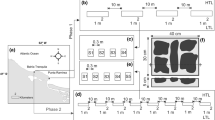Abstract.
An experiment and field study were carried out in order to investigate the epibiotic relationship between the hydroid Hydractinia angusta Hartlaub, 1904 and its host, the Antarctic scallop Adamussium colbecki (Smith, 1902), as well as the effect of H. angusta on the recruitment of scallop larvae, since both use the shells of adult A. colbecki as substratum. Four kinds of substrata, with and without epibionts, were exposed to the natural environment at 33 m depth. After 1 year, the analysis of substrata showed that: (1) the hydroid makes use of two substrate colonization strategies, depending on the presence/absence of other epibionts; (2) the settlement of A. colbecki larvae is strongly affected by substrate characteristics and by the presence of the hydroid. Hydroid colonies limit scallop recruitment on the upper valve of adults, where spats usually live for at least 3–5 years attached by means of byssus threads. In this way, the hydroid can affect A. colbecki life history in two ways: by defending, as is usually believed, adults from predators, as well as by limiting the recruitment of its own host.
Similar content being viewed by others
Author information
Authors and Affiliations
Additional information
Electronic Publication
Rights and permissions
About this article
Cite this article
Cerrano, C., Puce, S., Chiantore, M. et al. The influence of the epizoic hydroid Hydractinia angusta on the recruitment of the Antarctic scallop Adamussium colbecki. Polar Biol 24, 577–581 (2001). https://doi.org/10.1007/s003000100254
Accepted:
Issue Date:
DOI: https://doi.org/10.1007/s003000100254




